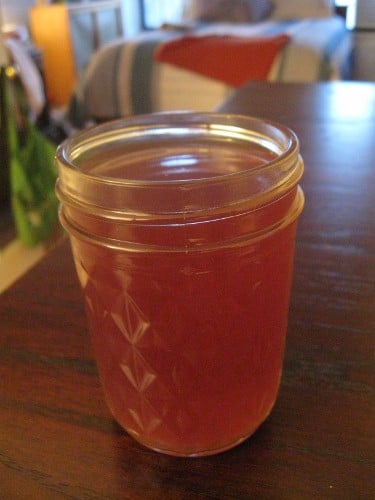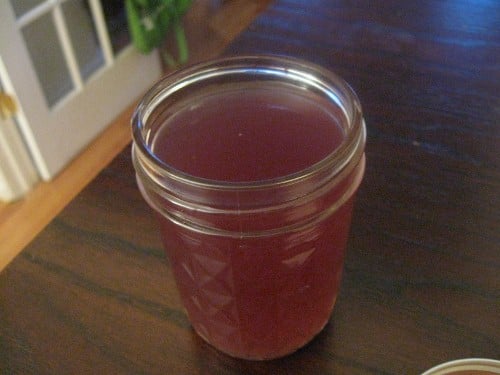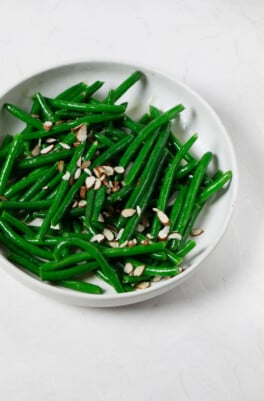Hi all!
Glad you liked the protein smoothie and info!
I got the following reader question a few days ago:
“Hey Gena!
I love your blog. I was hoping you might help me with an issue I’ve been having with raw foods: it seems as though all raw foodists are really into green lemonade or other juice in the morning. The thing is, I HATE juice! I’ve tried to like it. I’ve even tried some of your recipes. But I just can’t get used to it. Also, I find it really hard to drink cold juice in the winter. Is there anything I can drink instead of juice? I’d try green smoothies, but my understanding is that they don’t have the same benefits. Any tips you have would be appreciated…thanks!
Hannah”
Hey Hannah – great question!
Before we get into it, let’s break down what Hannah means when she says she wants a juice replacement. What she wants is a beverage that offers maximum nutrition in the form of minerals and vitamins, but puts virtually no stress on the body. (In other words, a nutrient-rich beverage that won’t activate digestion.) While smoothies and blended salads are typically nice alternatives to juice, they contain fiber, which means that they’ll invariable activate digestion and force the body to work as it takes in nutrients. So we need to think of a juice alternative that’s fiber-free.
My answer? Vegetable broth. Vegetable broth is not only tasty, nourishing, and a time-honored comfort food for vegetarian soup lovers, but an ideal way of attaining nutrition without doing digestive work. Bingo!
There are tons of vegetable broth options out there. As far as store bought options go, I recommend the Pacific brand’s organic, low-sodium broth. There are, of course, countless recipes to be found on the internet as well. Lately, I’ve been enjoying my own spin on Dr. Hyman’s Healing Veggie Broth, which my fellow health counselor Andrea shared with me. My recipe follows his closely—minus the onions and garlic, and with a few small tweaks. The result? A lovely, warm, and comforting broth that will nourish and heal you. The red cabbage addition, by the way, gives it a beautiful purple hue! Try the recipe yourselves and see:
Healing Veggie Broth (Based on a recipe from UltraSimple Diet, by Dr. Mark Hyman)
Makes 8 cups or 2 quarts
This recipe can be varied to taste. For every 3 quarts of water, add:
4 sliced carrots
1 cup daikon radish
2 cups winter squash cut into large cubes
1 cup root vegetables: turnips, parsnips, or rutabagas
2 cups chopped greens: kale, parsley, beet greens, collard greens, chard, dandelion, cilantro, or other greens
2-3 celery stalks
½ cup seaweed: nori, dulse, wakame, kelp, or kombu
1/4 head cabbage
4 ½ inch slices of fresh ginger
Sea salt to taste
If available you can add 1 cup fresh or dried shiitake or maitake mushrooms
Add all ingredients at once and place in a low boil for approximately 60 minutes. Boil to taste. Cool, strain, and store in a large, tightly sealed glass container in the fridge (I’ll bring it to work in mason jars, as you can see). Simply heat and drink!
Now, I should make one thing clear: there is no true substitute for green juice. The live enzyme rush, the abundance of vitamins, minerals, and iron, the magic of dark leafy greens: it’s irreplaceable! But that doesn’t mean that vegetable broth isn’t a wonderful alternative in winter months, or that it isn’t delicious and nourishing on its own terms.
If you’re looking for a winter drink that’s toasty and healing, give homemade veggie broth a try. It may sound daunting, but the truth is that nothing could be easier to make! I often boil whatever veggies I’ve got on hand for an hour when I’m doing housework on Sunday; by the time I get back to them, they’ve been transformed into a beautiful broth. And the leftover vegetables can be added to blended soups, if you wish.
Hope this helps, Hannah. Enjoy the broth, and good luck!
Have a great night, all.
This post may contain affiliate links. If you use these links to buy something I may earn a commission. Visit my privacy policy to learn more.





Leave a Comment
Hi Gena,
When I read your article, I thought of the old alchemical approach to making potent herbal medicines. The alchemists are careful to separate the elements that will be destroyed by head and then the process the remaining elements with heat and then combine the two.
For example, they use a Soxhlet tube extractor, which is a laboratory device that circulates hot alcohol, which condenses and then drips continuously on the dried herbs until all of the heat-sensitive essence of the herb has been released into the alcohol.
What is remaining also has value. So, the “thimble” is removed from the Soxhlet extractor and burned. The remaining ash is then combined with the tincture that was created. Now the two elements are combined into a single working medicine.
After your article inspired me, I went out and bought lots of fresh vegetables. I washed them and ran them through the Champion juicer to extract the juice (which, of course is heat sensitive). I quickly poured the juice into a baking pan and then slid it into the freezer to stabilize it as quickly as possible.
I took all the pulp from the juicing process and am simmering it for a couple of days to extract all the great minerals. In a couple days, when the pan of juice is thoroughly frozen, I’ll quickly take it out of the freezer to my counter, pound it into medium-sized pieces with a rubber mallet, place the pieces into quart freezer bags, slide the bags into the freezer before the juice thaws.
After a day or so of simmering the pulp, I’ll use a course and a fine-mesh strainer to remove all the fiber from the pot and put that in the compost heap. I’ll pour the broth into quart mason jars and refrigerate (I’ll use the broth within a few days).
To prepare my raw juice-broth, I’ll take a quart of broth out of the fridge and while it’s heating up, drop chunks of the frozen juice until it’s just warm enough to melt, but not so hot as to destroy the precious enzymes. It’s an interesting experiment!
Thank you for your ideas!
Ken
Hi,
I’m wondering why, on a diet like Mark Hyman’s, we can’t eat the vegetables as well…what is the benefit of just straight broth over all that good fiber in the soup?
I just made my first batch and am loathe to put all of those vegetables in the compost when I could be eating them!
Thanks for your input,
~Melissa
I just made a vegetable broth to drink whilst doing the fast diet – how many calories do you think it has. Mine was made with
1/3 of a celeriac
1/2 a yellow pepper
1 onion
3 cloves garlic
half a bag of kale
1/4 of a white cabbage
plenty of spices
a little sea salt – naturally dried
Do you think it counts as food (I strained it) and does this mean I have broken the fasting period 1:30 pm was my last meal – a green salad and my next one will be breakfast at 7am tomorrow.
I absolutely love this broth. I am drinking it for a detox fast, I am on day 3 and feel great! I agree with Rick, I didn’t fully boil my second batch and it was much better. I couldn’t find winter squash or seaweed but I added zucchini, mushrooms, turmeric root and a splash of Bragg’s Liquid Aminos. I will never buy broth again, this is my new go to recipe because cook with veggie broth often. I was wondering if you knew what the nutrients were in the broth? Just trying to prove to someone that i am still getting them while I am detoxing.
This is a great drink, especially for fasting but I don’t like to bring it to a boil. Too much heat can kill the vitamins though minerals will stay intact so instead I slowly simmer my veggies. My recipe includes kale, chard, cilantro, onion, bell pepper, ginger and garlic. This is a delicious warm beverage and great medicine.
i use the pulp from savory and vegetable and green juices and let them simmer on the stove for a short while and then let them sit overnight to steep in the warm water with the lid covered: the resulting broth is nutrient rich and i’ve truly taken advantage of all the nutrients in the vegetables, because i have juiced them first and then extracted the remaining nutrients from the pulp by making broth. broth lasts for two or max three days in the fridge. my husband will also use it (if theres a lot) instead of water to make his grains for extra flavor and nutrition. you can also save scraps and ends of veggies you’re using for other things and when they are enough use them to make broth. spicey broth is one of my favorite things especially when liquid fasting because it is a great source of electrolytes
I’m just beginning a two or three day broth fast and find that all things green, mixed with root vegetables (perhaps some fresh ginger but not sure how that will add to the vegy flavour?). Decades ago I did it with my husband – we actually managed 10 days. It was the most exhilerating, healthy thing I think I’ve ever done. The only problem is that the world is so focused on food that one needs to get beyond the first couple of days when you appetite dominates – then it goes away. I believe this is a cure for much of what ails us. I would like a raw foods book recommendation about how to go completely raw? So if anyone has idea please write me back.
:
Hi. Thanks so much. Can you give a rundown on the nutrional value of the broth. I love it and M just wondering what the value ie. thanks.
Seaweed may be the new multivitamin
“sea veg”, “seaveg”
I’ve tried several of your recipes and this, to date, is still my absolute favorite. I just boil off whatever is in my fridge and it’s amazing. I’m sick this weekend and remembered it, just made some using red cabbage like you suggest here, and you’re right, it’s such a lovely shade of purple!
The European Fasting experts such as Otto Buchinger, (Who supervisored over 100,000 fasts) and others all recommended vegetable broth along with raw juices during fasting. It is wonderfully tasty, and seems to provide minerals and electrolytes in a more absorbable form. It does require leaving behind the obsession with 100% “rawness.”
great idea — I’ll have to try the vegetable broth!
Mmm…great idea. I don’t have a juicer, and cold smoothies haven’t been as appealing to me in the cold weather. I love that the recipe includes seaweed too, which I love! I used to eat dulse by the handful as a kid.
Oh boy! This post makes for good timing. I am going on the Master Cleanse in two weeks and I have to eat/drink vegetable broth when I ween myself off the lemonade. This recipe looks tasty and I look forward to making it! I bet it will taste soo heavenly after the cayenne, maple syrup & lemon juice! Yikes!
Oh! Thank you very much, Gena! : )
I save all my veggie scraps (like ends and leftover bits), freeze them in large gallon-sized bags, and when I have enough I make broth for use in cooking. But sometimes, I do drink it alone. It’s mighty tasty. But I still like my green juice the best.
Thanks for this delicious sounding recipe. I always buy my vegetable broth from the store and have been wanting to make my own, as it’s much more nutritious.
Gena,
I recently bought a juicer and have been making my green juice at night. I keep the juice in the fridge overnight and then take it to work and drink it there. Is this okay? Or is most of the enzymes and nutrients gone by the time I drink it? I don’t have the option to make it in the morning before work.
Stephanie
Some vitamins (especially vitamin C) will be reduced, but there will still be enough goodness (including minerals, enzymes, and phytonutrients) in it that it is totally worth doing!
What a great idea, Gena! I’ve never thought about drinking veggie broth like a juice, but why not? The broth is always my favorite part of the soup, anyway! And you are so right about it being a comforting, cozy drink in these chilly months. Thanks for this!
Sounds like a great recipe any time of day. I love Pacific brand because they’re one of the few (even organic) brands that doesn’t add sugar 🙂
Thanks so much for sharing this recipe! I use Pacific brand’s broth, but sometimes it has a strange aftertaste to me, so I’d love to try making my own.
Hi Gena – thanks so much for the recipe. I’ve actually been saving in my freezer all the vegetables “leftovers” to make broth this weekend. The thing I haven’t figured out yet – what do you use as a strainer? This may sound silly, but I was picturing a pasta strainer??? I don’t own cheesecloth or a nut milk bag.
Thanks for the great post as always, LC
I use clean never to be used again pantyhose. Perfect strainers.
I am so grateful that I love my juice, regardless of the weather! Great option though.
I’ve never made homemade veggie broth before. Must undertake this rite of passage! Thanks, Gena 🙂
Gena, great info and recipe. I hate onions, garlic, and added salt/sodium so 99% of storebought soups are out for me. Even the reduced sodiums and I don’t get along so this is perfect! Thank you!
Hi Gena!
I was all about the juicing–which I still love. But about a month ago I switched to green smoothies for breakfast after having read that smoothies (because of the fiber) are the better way to go for first thing in the morning. Now, I’m confused again. Why do you advocate the morning juice?
Thanks!
Jeana
Hi Jeana,
I recommend reading my juicing vs. blending post to clear this up: https://www.thefullhelping.com/question-of-the-week-to-blend-or-to-juice/
Gena
Can’t wait to make this next week! It’s going to be a great cleanse supplement.
Boil? With all sincere respect for everything else I have seen from you so far, and not disputing that the recipe would probably be delicious taste wise, could you please explain how something boiled “for an hour” belongs in a raw diet? [I can relate to the aversion to cold juice in winter. Years ago, my answer personally was to chop up my veges, put them in a powerful blender, heat water pretty hot hot, dump the hot hot water into the blender onto the veges and hit the high button. Done correctly (and that is in the ratio of hot water to the vegetable mass and their temperatures), you end up with a warm soup at maybe 110 degrees– which is strainable through a nutmilk bag if you wish only broth.]
Hello, David:
As you can see from my “about” page, I’m not a strict raw foodist, or even a “raw foodist” in the traditional sense of the term. I actually don’t support a 100% raw diet for most people. I do, however, eat entirely vegan, and I encourage people to make more raw (both uncooked, and unprocessed) choices in their diets, which is what the title of this blog is all about. However, cooked vegan food is a very large and important part of my diet.
Gena
You are kind to answer, as it must have been obvious I had not read your ‘about’ section. Namaste.
Sometimes in the morning I love organic miso soup. South River Miso is my favorite company and they make soy-free varieties, too! Talk about nourishing and warming! 🙂 And, it’s so easy to make. Heat up some water and stir in some organic miso paste. Mmmmm…
Cheers XOXO,
Kristen
I looooove my green juice, but also look forward to something warm to sip on in the evenings. And I never thought of adding the sea veg to my broth, sounds really good.
Good question indeed! I love juice so much that I wouldn’t have thought of what juice-haters would do. This broth actually sounds REALLY, really good, esp. this time of year. I was thinking earlier this week that I might like to introduce some broth/miso soup into my AM/b’fast routine, and as usual, Gena reads my mind through the interwebs and comes through with a recipe. Thanks darlin’. 🙂
Interesting option, not sure it’s for me though because I’m loving my new juicer. But, maybe I will try on a cold morning. Thanks!
I meant to also add “thanks for the recipe!” I think I’ll make this. I have a daikon languishing in the fridge. Can I use nori sheets? That’s all I have.
Sure, you can use nori, and I meant 2-3 — thanks for the catch!
Is that really 23 celery stalks or should it be 2 – 3, which is more in line with the quantity of other veggies?
That broth sounds really good! Thank you for sharing the recipe 🙂
Still haven’t tried the juice…but really want to! This broth does look great, too!
I am with Hannah…can’t seem to jump on the juice wagon. I am going to try this broth though…I am a fan of Dr. Hyman!
As much as I love to cook, veggie broth was always one of those things that I never thought was worth the effort to make from scratch. But you make it sound so appealing – thanks for the recipe! 🙂